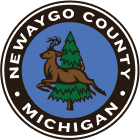The goal of the local emergency management program is to save lives, prevent property damage, and minimize damage to the environment. As Newaygo County is vulnerable to a wide range of natural, technological, and human-related hazards, one of the first steps of building an effective emergency management program is to develop an understanding of those threats. This can be accomplished through the development of a Hazard Analysis. Once complete, a Mitigation Plan can be developed to identify the community’s long-term strategy to reduce disaster damages to lives, property, and the economy from future disasters.
Purpose of the Hazard Analysis
A hazard analysis provides an understanding of the potential threats facing the community. By pinpointing the location, extent and magnitude of past disasters or emergency situations, and by examining knowledge of new or emerging risks, it is possible to determine the probability of such events occurring and the vulnerability of people and property. Coupled with relevant land use, economic and demographic information from a well prepared “community profile,” Emergency Management Directors/Coordinators can make assumptions about those segments of the community that might be impacted by various types of incidents. This, in turn, allows them to set priorities and goals for resource allocation and response, recovery and mitigation activities prior to an incident occurring. Collectively, these decisions are the cornerstone of the community’s emergency management program and should guide all decisions pertaining to community emergency management activities.
Purpose of Hazard Mitigation
Hazard mitigation is any action taken before, during, or after a disaster to permanently eliminate or reduce the long-term risk to human life and property from natural, technological, and man-made hazards. The purpose of mitigation planning is to identify policies and actions that can be implemented over the long term to reduce risk and future losses. Mitigation Plans form the foundation for a community’s long-term strategy to reduce disaster losses and break the cycle of disaster damage, reconstruction, and repeated damage. The planning process is as important as the plan itself. It creates a framework for risk-based decision making to reduce damages to lives, property, and the economy from future disasters.
Local governments benefit from mitigation planning by:
- Identifying cost effective actions for risk reduction that are agreed upon by stakeholders and the public
- Focusing resources on the greatest risks and vulnerabilities
- Building partnerships by involving people, organizations, and businesses
- Increasing education and awareness of hazards and risk
- Communicating priorities to state and federal officials
- Aligning risk reduction with other community objectives
Hazard Mitigation Assistance
State, Indian Tribal, and local governments are required to develop a hazard mitigation plan as a condition for receiving certain types of non-emergency disaster assistance. Please visit the Hazard Mitigation Assistance page at https://www.fema.gov/hazard-mitigation-assistance for more information on the specific plan requirements for the various mitigation grant programs, as well as FEMA funds available for mitigation plan development and mitigation projects.
Newaygo County’s Hazard Management Plan
The Newaygo County Hazard Management Plan is a multi-jurisdictional hazard mitigation plan developed pursuant to the criteria contained in 44CFR Part 201, as authorized by the Disaster Mitigation Act of 2000. This plan is required in order to maintain eligibility to seek federal funding under the Hazard Mitigation Assistance Grant Program. The Newaygo County Hazard Management Plan was originally developed in 2004 – 2007 by Newaygo County Emergency Services with the assistance of the West Michigan Shoreline Regional Development Commission, and in cooperation with the Michigan State Police, Emergency Management and Homeland Security Division. The original plan was adopted by the Newaygo County Board of Commissioners via resolution 08-024-07 in 2007.
In 2012, the revision process began under the FY2010 Hazard Mitigation Assistance (HMA) program grant. This revision process was completed in 2015. On July 22, 2015, resolution 08-024-07 was repealed by resolution 07-023-15 adopting the Newaygo County Hazard Management Plan 2015 Edition as the official Hazard Mitigation Plan for the County of Newaygo. This plan is required to up updated every five years.
The existing Newaygo County Hazard Management Plan will expire in August 2020. Newaygo County has received a grant under the FY 2018 Pre-Disaster Mitigation Grant Program in order revise and reauthorize the plan. A draft Community Profile has been developed by Newaygo County Emergency Services. This document has been reviewed by the Local Emergency Planning Team on October 15, 2019. However, in order to meet FEMA requirements for Hazard Mitigation Planning, Newaygo County has posted the draft Community Profile for review and comment.
Newaygo County is requesting the public’s assistance with reviewing the Hazard Analysis. Please take a few moments of your time to respond to the following survey:
Newaygo County Hazard Management Survey
If you have any questions or comments in relation to the Community Profile or Hazard Mitigation Planning, please contact Emergency Services Director Abby Watkins at (231) 689-7354 or email abbym@newaygocountymi.gov
If you have any questions or comments in relation to the Community Profile or Hazard Analysis, please contact the Newaygo County Emergency Services Department. Thank you!



